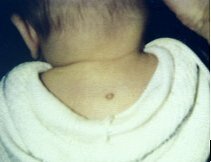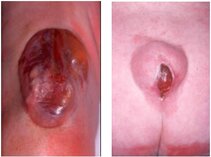Congenital deformities of the spine and the spinal cord
Spina bifida
Spina bifida means a developmental disorder of the spine and the spinal cord. There are different forms with accordingly various neurological deficits.
Spina bifida occulta
In case of Spina bifida occulta (occult or closed malformation/dysraphism) which is a gap in the vertebrae and covered by soft tissue, the processus spinosus of one or several lumbar vertebrae are missing. The covering skin is intact.
The neurological examination results are normal at first. But discoloration of the skin, abnormal hair growth, skin appendices, fat pads, or a retraction/stricture of skin draw attention on the hidden spinal deformities.
It might be a tumour such as an epidermoid or a dermoid. Also a lipoma (benign fat lump) or a diastematomyelia (split spinal cord) may occur. In some cases it is simply the fatty thickened end of the string of the spinal cord (filum terminale).
An early neurosurgical examination is necessary because a tethered cord syndrome, which is an adhesion of extensions of the spinal cord with the spinal canal, exists at the same time. This involves possible neurological symptoms in the course of the child’s development. An early presentation of the patient will help to choose the best point in time for surgery.
Spina bifida aperta
Spina bifida aperta, (the so-called open spine/back), is the most common form of defects of the neural tube and develops between the 21st and 28th day of pregnancy. It is most probably caused by different factors. With a prophylaxis of folic acid (prior to conception!) and through improved prenatal diagnosics, the number of newly diagnosed children at the time of birth is falling.
The incomplete closing of the embryonic spinal column/neural tube, the so-called dysraphism, is identifiable by a mass located in the dorsal midline. This mass is covered with skin (meningocele) or with a membrane (myelomeningocele). It contains liquor and meninges in case of a meningocele and the undeveloped neural plate (thickened plate of ectoderm from which the neural tube develops) in case of a myelomeningocele.
The neurological deficits are dependent on the location and extension of the defect and are irreversible. In most cases, spina bifida aperta occurs along with other defects such as hydrocephalus, Chiari malformation, syringomyelia, and tethered cord syndrome. Besides these neurological deformities, further defects in the orthopaedic field may occur, such as high arches, hip luxations, scoliosis and kyphosis. Furthermore, in the field of general surgery with inguinal hernia and in the urological sector with urinary bladder disorders, defects may occur.
For these children, not only a surgery for covering the defect (preferably within the first 48 hours after birth), is necessary but numerous further surgeries, too. A close cooperation with and within a specialised medical center is highly recommended.
For all forms of spina bifida, we offer an interdisciplinary spina bifida outpatient department where lifetime medical care with supportive recommendations und treatment options is provided. A well-functioning support group might also be very helpful for these patients and their relatives.

Dr. Mukesch Shah, MD
Senior neurosurgeon
Children consultation hours

Dr. Florian Volz, MD
Attending neurosurgeon


